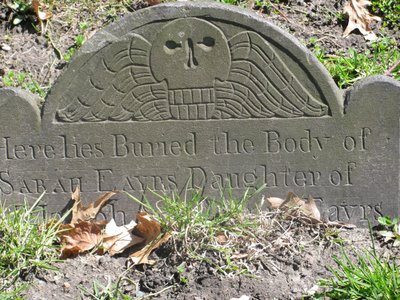












from Wikipedia>>
The Granary Burying Ground is the 3rd cemetery established in the city of Boston, dating to the year 1660. The need for the site arose because the land set aside for the city's first cemetery, King's Chapel Burying Ground located a block east was insufficient to meet the city's growing population. Early in its existence the area was known as the South Burying Ground until 1737 at which point it took on the name of the granary building which formerly stood on the site of what is now the Park Street Church. In May 1830 trees were planted in the area and an attempt was made to change the name to “Franklin Cemetery” to honor the family of Benjamin Franklin, but the effort failed.
The Burying Ground was originally part of the Boston Common which originally encompassed the entire block, but two years after the cemetery was established the southwest portion of the block was taken for public buildings, which included the Granary and a house of correction[2] and the north portion of the block was used for housing.
Tombs were initially placed near the back of the property and on 15 May 1717 a vote was passed by the town to enlarge the Burying Ground by taking part of the highway on the eastern side, (now Tremont Street). The enlargement was carried out in 1720 when 15 tombs were created and assigned to a number of Boston families.
--
I was struck by the extrodinary liveliness of line, of spirit and of image that was expressed at this significant graveyard. Yes, there were many stones that were to the raw eye, probably developed, cut and finished by the same artists. However, even in those "gimme one of those" moments, how each stone had a special attitude, spirit that suited the stone that was selected (with many of them having the carving and lettering conform to the basic shape of the stone), the depth and fineness of the line, and the expression of the faces/skulls. I was intrigued by the way the wings even in this small community of stones were different from a central form from which feather forms developed either horizontally or vertically. There were some pomegranates, pinecones, masonic symbols, and sometimes a stacked spirit effigy and skull combination.
I am charmed by the stone with the heart as the central vehicle to hold the type . In the same manner, I am charmed by the stone with the urn that holds the type. This is originality that is not the same as the look in this neighborhood for the afterlife. I just got a great book on American printer's woodcuts/etchings. There are a few examples of handbills notifying the public of a death at this same time. It is a fascinating juxtaposition that somehow dimensionalizes these stone versions....Unfortunately, I didn't shake poor old Memento Mori out of my system when I stopped a while back. I think there are more images (perhaps a bit more refined) but more images nonetheless.
